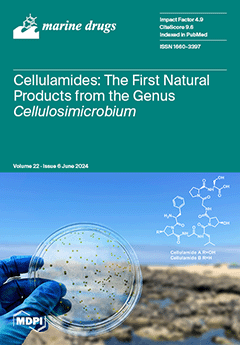Three polysaccharides (SnNG, SnFS and SnFG) were purified from the body wall of
Stichopus naso. The physicochemical properties, including monosaccharide composition, molecular weight, sulfate content, and optical rotation, were analyzed, confirming that SnFS and SnFG are sulfated polysaccharides commonly found in sea
[...] Read more.
Three polysaccharides (SnNG, SnFS and SnFG) were purified from the body wall of
Stichopus naso. The physicochemical properties, including monosaccharide composition, molecular weight, sulfate content, and optical rotation, were analyzed, confirming that SnFS and SnFG are sulfated polysaccharides commonly found in sea cucumbers. The highly regular structure {3)-L-Fuc
2S-(α1,}
n of SnFS was determined via a detailed NMR analysis of its oxidative degradation product. By employing β-elimination depolymerization of SnFG, tri-, penta-, octa-, hendeca-, tetradeca-, and heptadeca-saccharides were obtained from the low-molecular-weight product. Their well-defined structures confirmed that SnFG possessed the backbone of {
D-GalNAc
4S6S-β(1,4)-
D-GlcA}, and each GlcA residue was branched with Fuc
2S4S. SnFS and SnFG are both structurally the simplest version of natural fucan sulfate and fucosylated glycosaminoglycan, facilitating the application of low-value sea cucumbers
S. naso. Bioactivity assays showed that SnFG and its derived oligosaccharides exhibited potent anticoagulation and intrinsic factor Xase (iXase) inhibition. Moreover, a comparative analysis with the series of oligosaccharides solely branched with Fuc
3S4S showed that in oligosaccharides with lower degrees of polymerization, such as octasaccharides, Fuc
2S4S led to a greater increase in APTT prolongation and iXase inhibition. As the degree of polymerization increases, the influence from the sulfation pattern diminishes, until it is overshadowed by the effects of molecular weight.
Full article






